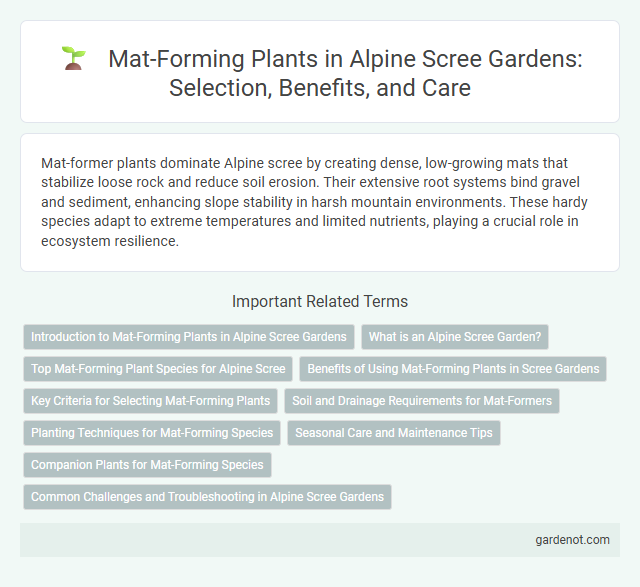Mat-former plants dominate Alpine scree by creating dense, low-growing mats that stabilize loose rock and reduce soil erosion. Their extensive root systems bind gravel and sediment, enhancing slope stability in harsh mountain environments. These hardy species adapt to extreme temperatures and limited nutrients, playing a crucial role in ecosystem resilience.
Introduction to Mat-Forming Plants in Alpine Scree Gardens
Mat-forming plants in alpine scree gardens play a crucial role in stabilizing loose, rocky substrates and preventing soil erosion. Species such as Saxifraga, Silene, and Androsace spread horizontally, creating dense, low-growing mats that retain moisture and protect roots from harsh alpine conditions. Their adaptive traits, including drought resistance and shallow root systems, enable survival in nutrient-poor scree environments while supporting biodiversity.
What is an Alpine Scree Garden?
An Alpine scree garden is a specialized landscape designed to mimic the natural rocky slopes found in high mountain environments, integrating well-drained, gritty soil and drought-tolerant plants like saxifrages, sedums, and alpine asters. This garden type replicates the scree habitat where plants have adapted to harsh conditions, including temperature extremes and nutrient-poor substrates. Mat-forming alpine plants, such as creeping phlox and cushion plants, play a crucial role in stabilizing soil and preventing erosion while creating low-growing, dense mats that enhance the garden's visual appeal.
Top Mat-Forming Plant Species for Alpine Scree
Key mat-forming plant species for alpine scree include Phlox subulata, Saxifraga paniculata, and Diapensia lapponica, which excel at stabilizing loose rocky substrates. These species exhibit dense, low-growing mats that minimize soil erosion by securing scree particles and enhancing moisture retention in harsh alpine environments. Their adaptive traits, such as drought tolerance and resistance to temperature extremes, make them vital for ecological succession and habitat formation on unstable scree slopes.
Benefits of Using Mat-Forming Plants in Scree Gardens
Mat-forming plants enhance stability in alpine scree gardens by reducing soil erosion through dense ground cover. Their low-growing, spreading habit conserves moisture and suppresses weed growth, promoting a healthier microenvironment. These plants also provide essential habitats for alpine wildlife, contributing to biodiversity in challenging scree conditions.
Key Criteria for Selecting Mat-Forming Plants
Key criteria for selecting mat-forming plants in alpine scree include their root structure, drought tolerance, and growth rate. Plants with deep, fibrous roots stabilize loose scree, while drought-resistant species endure harsh alpine conditions. Rapid growth and low maintenance ensure quick ground coverage, reducing soil erosion effectively.
Soil and Drainage Requirements for Mat-Formers
Mat-formers thrive in well-drained, rocky alpine scree environments where soil is typically coarse, gritty, and low in organic matter. These plants require minimal soil moisture retention, favoring substrates that prevent waterlogging and promote rapid drainage. Optimal growth occurs in alkaline to neutral pH conditions, which facilitate nutrient uptake in nutrient-poor scree habitats.
Planting Techniques for Mat-Forming Species
Effective planting techniques for mat-forming species on alpine scree involve careful soil preparation to ensure stability and nutrient availability. Selecting species with low growth habits and deep rooting systems enhances erosion control and mat development. Optimal spacing and consistent moisture levels promote rapid ground cover establishment and resilience against harsh alpine conditions.
Seasonal Care and Maintenance Tips
Mat-former ground covers in alpine scree environments require seasonal care to thrive, including regular inspection for debris accumulation and ensuring proper drainage to prevent root rot during wetter months. Removing dead foliage and trimming back excessive growth in early spring promotes healthy regeneration and maintains the plant's mat-like structure. Applying a balanced, slow-release fertilizer at the start of the growing season supports sustained growth and resilience against harsh alpine conditions.
Companion Plants for Mat-Forming Species
Companion plants for alpine scree mat-forming species enhance soil stabilization and microhabitat conditions, promoting biodiversity within harsh mountainous environments. Common companions include cushion plants like Silene acaulis and saxifrages, which share similar drought-tolerant and low-nutrient requirements. These species collectively create protective mats that reduce erosion and support thermal regulation on exposed scree slopes.
Common Challenges and Troubleshooting in Alpine Scree Gardens
Mat-former plants in alpine scree gardens frequently face challenges such as poor drainage, root rot, and nutrient deficiencies due to rocky substrate conditions. Effective troubleshooting involves ensuring well-drained soil with ample grit, avoiding overwatering, and supplementing with micronutrient-rich fertilizers adapted to alpine environments. Monitoring for signs of fungal infections and adjusting microclimate exposure can prevent common mat-former decline in high-altitude scree landscapes.
Mat-former Infographic

 gardenot.com
gardenot.com